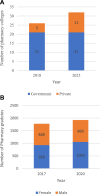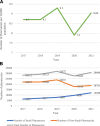An analysis of pharmacy workforce capacity in Saudi Arabia
- PMID: 37601049
- PMCID: PMC10434764
- DOI: 10.3389/fphar.2023.1219528
An analysis of pharmacy workforce capacity in Saudi Arabia
Abstract
Background: Previous reports have highlighted the core issues with the intelligence of the national pharmacy workforce reliance on non-native pharmacists, despite the increasing supply of local pharmacy graduates; limited participation of female pharmacists in the workforce; and inadequate proportions of pharmacists in primary healthcare centres, resulting in pharmaceutical services being provided without a pharmacist's supervision. Methods: The current study used a retrospective cross-sectional design and data was collected from January to May 2023. Data was retrieved from the Health Statistics Yearbook, 2017, 2018, 2019, 2020 and 2021. The data included the total number of pharmacists, the number of Saudi pharmacists, the number of foreign pharmacists, the distribution of the proportions of male and female pharmacists, and the distribution of the workforce by region, sector and nationality. Data was also obtained relating to pharmacy education, including the number of pharmacy colleges, the number of pharmacy students and the number of pharmacy graduates. Results and conclusion: The capacity of the pharmacy workforce, meaning the number of pharmacists per 10,000 population, fluctuated between 2017 and 2021, with the lowest number being in 2020, a mere 7.9 pharmacists per 10,000 population. However, in 2021, the overall density of pharmacists increased to (9.04), which is above the global average (7.36 per 10,000 population). The proportion of women working in the pharmacy profession increased from 12% to 22%, and in community pharmacies from 0.3% to 7.2%, between 2016 and 2021. Another issue that still exists is a lack of proportionate and imbalance in the distribution of the pharmacy workforce across the regions. The renationalisation initiatives increased the overall proportion of Saudi pharmacists to 39% in 2021, compared to 22% in 2016. There is a need for a policy mechanism that will overcome the identified issues.
Keywords: Saudi Arabia; pharmacy; supply and demand; workforce capacity; workforce intelligence.
Copyright © 2023 Almaghaslah.
Conflict of interest statement
The author declares that the research was conducted in the absence of any commercial or financial relationships that could be construed as a potential conflict of interest.
Figures





Similar articles
-
Pharmacy workforce in Saudi Arabia: Challenges and opportunities: A cross-sectional study.Int J Health Plann Manage. 2019 Jan;34(1):e583-e593. doi: 10.1002/hpm.2674. Epub 2018 Sep 28. Int J Health Plann Manage. 2019. PMID: 30265404
-
A Cross-Sectional Study on Pharmacy Students' Career Choices in the Light of Saudi Vision 2030: Will Community Pharmacy Continue to Be the Most Promising, but Least Preferred, Sector?Int J Environ Res Public Health. 2021 Apr 26;18(9):4589. doi: 10.3390/ijerph18094589. Int J Environ Res Public Health. 2021. PMID: 33926047 Free PMC article.
-
Trends, Capacity Growth, and Current State of Community Pharmacies in Saudi Arabia: Findings and Implications of a 16-Year Retrospective Study.Risk Manag Healthc Policy. 2023 Dec 21;16:2833-2847. doi: 10.2147/RMHP.S443325. eCollection 2023. Risk Manag Healthc Policy. 2023. PMID: 38146313 Free PMC article.
-
Multi-stakeholder perspective on community pharmacy services in Saudi Arabia: A systematic review and meta-analyses for 2010-2020.Explor Res Clin Soc Pharm. 2025 Apr 28;18:100608. doi: 10.1016/j.rcsop.2025.100608. eCollection 2025 Jun. Explor Res Clin Soc Pharm. 2025. PMID: 40417230 Free PMC article. Review.
-
The changing roles of pharmacists in community pharmacies: perception of reality in India.Pharm World Sci. 2009 Dec;31(6):612-8. doi: 10.1007/s11096-009-9307-y. Epub 2009 Jun 25. Pharm World Sci. 2009. PMID: 19554470 Review.
Cited by
-
Perceived Needs, Barriers, and Challenges to Continuing Professional Development (CPD): A Qualitative Exploration among Hospital Pharmacists.Pharmacy (Basel). 2024 Sep 12;12(5):140. doi: 10.3390/pharmacy12050140. Pharmacy (Basel). 2024. PMID: 39311131 Free PMC article.
-
Professional self-actualisation of pharmacist in the United Arab Emirates: a pilot study.J Pharm Policy Pract. 2025 Jan 9;18(1):2443524. doi: 10.1080/20523211.2024.2443524. eCollection 2025. J Pharm Policy Pract. 2025. PMID: 39802456 Free PMC article.
-
Knowledge, Attitude, and Perception of Health Care Providers Providing Medication Therapy Management (MTM) Services to Older Adults in Saudi Arabia.Healthcare (Basel). 2023 Nov 10;11(22):2936. doi: 10.3390/healthcare11222936. Healthcare (Basel). 2023. PMID: 37998428 Free PMC article.
-
Accreditation of pharmacy programs and its impact on SPLE success and pharmacist readiness in Saudi Arabia.Front Med (Lausanne). 2024 Nov 7;11:1490555. doi: 10.3389/fmed.2024.1490555. eCollection 2024. Front Med (Lausanne). 2024. PMID: 39574907 Free PMC article.
-
Comparing knowledge, attitudes, and practices in cardiovascular disease prevention and health promotion between community and hospital pharmacists in Saudi Arabia: A cross-sectional study.Saudi Pharm J. 2024 Jan;32(1):101890. doi: 10.1016/j.jsps.2023.101890. Epub 2023 Dec 1. Saudi Pharm J. 2024. PMID: 38192383 Free PMC article.
References
-
- Albejaidi F., Nair K. S. (2021). Nationalisation of health workforce in Saudi arabia’s public and private sectors: A review of issues and challenges. J. Health Manag. 23 (3), 482–497. 10.1177/09720634211035204 - DOI
LinkOut - more resources
Full Text Sources

